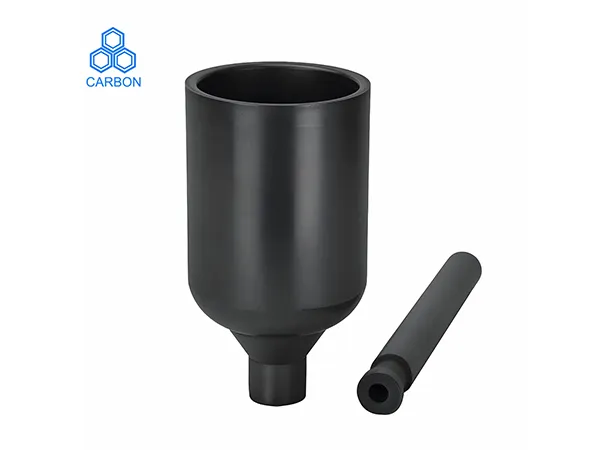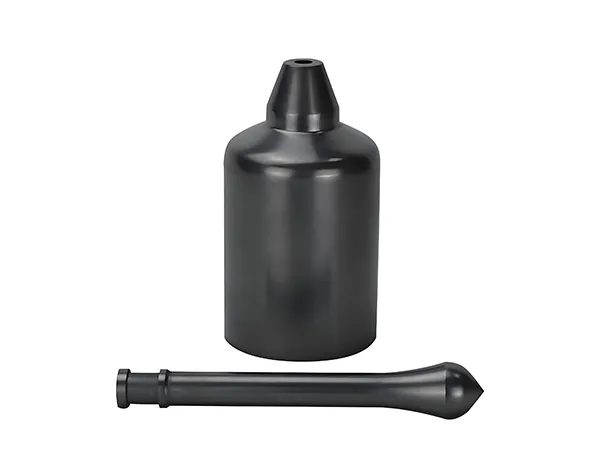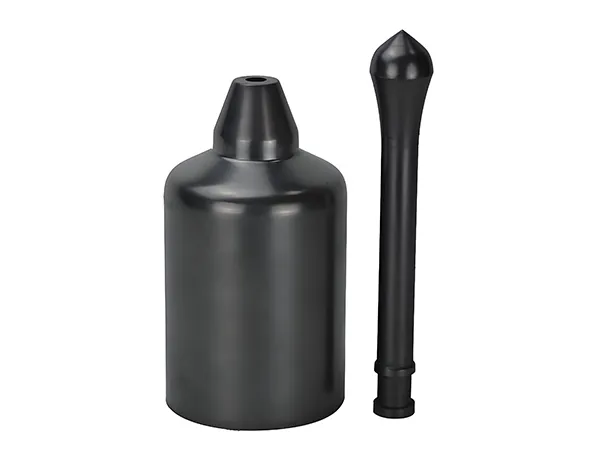Time: 2025-10-13 12:52:04 Source: Cangzhou Carbon Technology Co., Ltd.
In the foundry industry, choosing the right equipment is crucial for production efficiency and product quality. As the core vessel in the metal smelting process, the performance of the graphite crucible directly impacts smelting results, energy consumption, and even operational safety. So, with a wide variety of graphite crucibles on the market, why do some offer long lifespans and high efficiency, while others frequently break down and increase costs? How can your foundry make an informed choice?

Simply put, the lifespan and efficiency of a graphite crucible are primarily determined by factors such as the manufacturing process and materials, as well as operation, operation, and maintenance.
This is the fundamental reason for performance differences.
1. Manufacturing Process: The Core of the Core
Isostatic Pressing vs. Extrusion/Compression Molding
Isostatic Pressing (a modern, high-end process): This is the mainstream technology for manufacturing high-performance graphite crucibles. Graphite powder is placed in a flexible mold and uniformly applied to the crucible from all directions through a liquid. This results in an extremely dense and uniformly distributed crucible, like a dense layer cake with no weak points. Advantages: Extremely high mechanical strength, excellent thermal conductivity, exceptional thermal shock resistance (resistance to rapid heating and cooling), uniform wall thickness, and rapid heating.
Results: Long service life, high melting efficiency, and low energy consumption.
Extrusion/Compression Molding (Traditional Process): Using unidirectional or bidirectional pressure, density and structural uniformity are far inferior to isostatic pressing.
Disadvantages: Density gradients occur, making it prone to invisible cracks or stress concentration points. Under high temperatures and the impact of molten metal, these weak points will crack first, shortening service life.
2. Raw Materials: Graphite Grade and Formulation
High-purity, large-particle artificial graphite: Features a more complete crystal structure, improved thermal conductivity, higher strength, and greater oxidation resistance. Crucibles using this material naturally have a longer lifespan and higher efficiency.
Natural Graphite and Binder: Traditional crucibles often use a mixture of natural graphite and clay. Clay as a binder reduces the crucible's thermal conductivity and thermal shock resistance, making it more susceptible to cracking during repeated heating and cooling cycles. Anti-oxidation Impregnation: High-end crucibles undergo a special anti-oxidation impregnation treatment during the manufacturing process. This creates a protective film on the graphite particles, significantly slowing oxidation at high temperatures. This is one of the key technologies that extend their lifespan.

Even if you buy a top-notch crucible, improper handling can lead to its premature demise.
1. Heating and Cooling: Thermal shock is the number one killer.
Not preheating or improper preheating: Placing a cold crucible directly into a high-temperature furnace, or heating it too quickly, can cause a significant temperature difference between the inner and outer layers of the crucible, leading to uneven expansion and instant cracking.
Excessive cooling: Immediately after melting, removing a hot crucible from the furnace and placing it on the cold floor or exposed to cold air can also cause cracking due to the drastic contraction.
2. Charging and Cleaning: Accumulation of Physical Damage
Improper charging: Roughly adding large pieces of metal can directly impact the bottom or inner wall of the crucible, causing microcracks that are difficult to detect with the naked eye. Wall Sticking and Slagging: If slag adhered to the crucible walls is not thoroughly removed after smelting, the different expansion coefficients of the slag and crucible walls during the next heating will generate significant stress, causing the crucible walls to tear and crack.
Using Inappropriate Tools: Hitting or poking the crucible with a sharp iron rod can cause direct mechanical damage.
3. Compatibility and Standard Operation
Erosion of the Molten Metal and the Furnace:
When smelting certain reactive metals (such as alloys containing manganese and titanium) or oxides, they chemically react with the crucible walls, corroding the crucible.
Improper furnace design allows the flame or heat to directly impact certain parts of the crucible, causing localized overheating and oxidation.
Overloading: Charging the crucible beyond its rated safety capacity not only increases the risk of cracking but also significantly reduces thermal efficiency.
Using a Furnace Cover: Not covering the furnace cover during smelting exposes the upper portion of the crucible to air, causing excessive oxidation, thinning, and brittleness, making it prone to edge chipping. Therefore, to select a long-lasting, high-efficiency graphite crucible, foundries need to do the following:
1. Understand Your Melting Needs: Metal Type and Temperature
First, you need to determine which metals your foundry primarily melts and the maximum melting temperature required.
Non-ferrous metals (such as aluminum, copper, and brass): Most standard graphite crucibles handle the melting temperatures of these metals well. However, for copper alloys, you may need to consider a higher-density crucible to resist corrosion.
Precious metals (such as gold and silver): These metals require a higher purity crucible to avoid contamination from impurities.
Special alloys: If you are melting special alloys with high melting points or chemically sensitive properties, you will need a custom or specially formulated graphite crucible, which generally offers enhanced resistance to oxidation and chemical attack.
Tip: Different graphite crucibles have different maximum operating temperatures and corrosion resistance. Choosing a crucible that meets your maximum melting temperature requirements and exhibits good chemical inertness to the metal you are melting is paramount.

2. Consider the crucible's material and manufacturing process.
The performance of a graphite crucible is closely related to its material (graphite purity, additives) and manufacturing process (isostatic pressing, vibration forming).Pure graphite crucibles: Offer excellent thermal conductivity and high-temperature resistance, but can be brittle and have limited oxidation resistance. They are often used in laboratories or for smelting applications requiring extremely high purity.
Clay graphite crucibles: A clay binder is added to the graphite, enhancing the crucible's strength and thermal shock resistance. They are relatively low-cost and the most common type in industry.
Silicon carbide graphite crucibles: Containing silicon carbide, they significantly enhance the crucible's strength, wear resistance, and oxidation resistance. They are particularly suitable for smelting highly corrosive metals such as copper, brass, and bronze. They generally have a longer service life.
Tip: While silicon carbide graphite crucibles may require a slightly higher initial investment, their longer service life and improved efficiency make them more cost-effective in the long term.
3. Evaluate Crucible Size and Capacity
The crucible size and capacity must match your furnace type and production scale.
Furnace Matching: Ensure the crucible's diameter and height are perfectly adapted to your induction, resistance, or gas furnace. Oversize or undersize can affect heating efficiency and safety.
Production Requirements: Select the appropriate crucible capacity based on the amount of metal you melt each time and your daily output. Avoid frequent refills or melting too little at a time to optimize your production process.
Tip: Discuss your furnace type and specific size requirements with your crucible supplier; they can often provide professional matching recommendations.
4. Value the Supplier's Reputation and Technical Support
Choosing an experienced and reputable crucible supplier is equally important.
Product Quality: A good supplier will provide products with consistent quality and reliable performance.
Technical Support: They can provide professional selection advice, usage guidance, and after-sales service. If you encounter any problems during use, you can get timely solutions.
Customization Capabilities: If your foundry has special needs, the supplier's customization capabilities are crucial. Tip: Before making a final decision, ask the supplier for product samples for testing and consult other user reviews.
5. Consider Cost-Effectiveness and Lifespan
While the initial investment is important, the overall cost-effectiveness of the crucible should be considered even more.
Lifespan: While high-quality crucibles may be slightly more expensive, their longer lifespan means less frequent replacement, less downtime, and higher productivity.
Energy Consumption: Crucibles with excellent thermal conductivity can shorten melting times and reduce energy consumption.
Maintenance Costs: Crucibles that are easy to maintain and resistant to cracking can reduce unplanned downtime and repair costs.
Tip: Don't just look at the unit price of a crucible; calculate its "cost per hour" or "cost per ton of metal melted" to assess its true economic viability.
Choosing the right graphite crucible is a multifaceted decision that requires comprehensive consideration. By carefully evaluating your melting needs, crucible material, size compatibility, supplier reputation, and overall cost-effectiveness, you will be able to select the optimal graphite crucible for your foundry, thereby increasing production efficiency, reducing operating costs, and ultimately improving the quality and competitiveness of your products.